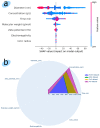Prediction of Dynamic Toxicity of Nanoparticles Using Machine Learning
- PMID: 39453170
- PMCID: PMC11511391
- DOI: 10.3390/toxics12100750
Prediction of Dynamic Toxicity of Nanoparticles Using Machine Learning
Abstract
Predicting the toxicity of nanoparticles plays an important role in biomedical nanotechnologies, in particular in the creation of new drugs. Safety analysis of nanoparticles can identify potentially harmful effects on living organisms and the environment. Advanced machine learning models are used to predict the toxicity of nanoparticles in a nutrient solution. In this article, we performed a comparative analysis of the current state of research in the field of nanoparticle toxicity analysis using machine learning methods; we trained a regression model for predicting the quantitative toxicity of nanoparticles depending on their concentration in the nutrient solution at a fixed point in time with the achieved metrics values of MSE = 2.19 and RMSE = 1.48; we trained a multi-class classification model for predicting the toxicity class of nanoparticles depending on their concentration in the nutrient solution at a fixed point in time with the achieved metrics values of Accuracy = 0.9756, Recall = 0.9623, F1-Score = 0.9640, and Log Loss = 0.1855. As a result of the analysis, we concluded the good predictive ability of the trained models. The optimal dosages for the nanoparticles under study were determined as follows: ZnO = 9.5 × 10-5 mg/mL; Fe3O4 = 0.1 mg/mL; SiO2 = 1 mg/mL. The most significant features of predictive models are the diameter of the nanoparticle and the nanoparticle concentration in the nutrient solution.
Keywords: artificial intelligence; nanoparticles; prediction; toxicity.
Conflict of interest statement
The authors declare no conflicts of interest.
Figures











Similar articles
-
Toxicity prediction of nanoparticles using machine learning approaches.Toxicology. 2024 Jan;501:153697. doi: 10.1016/j.tox.2023.153697. Epub 2023 Dec 14. Toxicology. 2024. PMID: 38056590
-
A Comparative Study of Automated Machine Learning Platforms for Exercise Anthropometry-Based Typology Analysis: Performance Evaluation of AWS SageMaker, GCP VertexAI, and MS Azure.Bioengineering (Basel). 2023 Jul 27;10(8):891. doi: 10.3390/bioengineering10080891. Bioengineering (Basel). 2023. PMID: 37627775 Free PMC article.
-
Development and validation of a web-based artificial intelligence prediction model to assess massive intraoperative blood loss for metastatic spinal disease using machine learning techniques.Spine J. 2024 Jan;24(1):146-160. doi: 10.1016/j.spinee.2023.09.001. Epub 2023 Sep 11. Spine J. 2024. PMID: 37704048 Clinical Trial.
-
Predicting the toxicity of nanoparticles using artificial intelligence tools: a systematic review.Nanotoxicology. 2023 Feb;17(1):62-77. doi: 10.1080/17435390.2023.2186279. Epub 2023 Mar 8. Nanotoxicology. 2023. PMID: 36883698
-
Machine Learning and Artificial Intelligence in Toxicological Sciences.Toxicol Sci. 2022 Aug 25;189(1):7-19. doi: 10.1093/toxsci/kfac075. Toxicol Sci. 2022. PMID: 35861448 Free PMC article. Review.
Cited by
-
AI-based nanotoxicity data extraction and prediction of nanotoxicity.Comput Struct Biotechnol J. 2025 Apr 3;29:138-148. doi: 10.1016/j.csbj.2025.03.052. eCollection 2025. Comput Struct Biotechnol J. 2025. PMID: 40255458 Free PMC article.
References
-
- Servin A.D., White J.C. Nanotechnology in agriculture: Next steps for understanding engineered nanoparticle exposure and risk. NanoImpact. 2016;1:9–12. doi: 10.1016/j.impact.2015.12.002. - DOI
-
- Ghobashy M.M., Alkhursani S.A., Alqahtani H.A., El-damhougy T.K., Madani M. Gold nanoparticles in microelectronics advancements and biomedical applications. Mater. Sci. Eng. B. 2024;301:117191. doi: 10.1016/j.mseb.2024.117191. - DOI
Grants and funding
LinkOut - more resources
Full Text Sources
Research Materials

